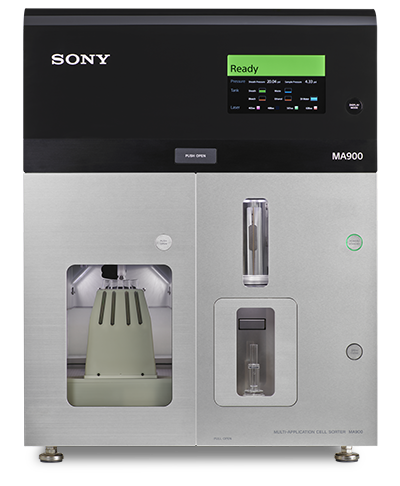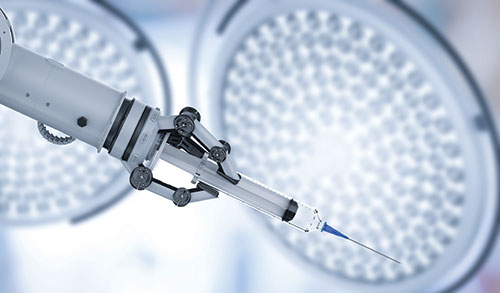

Engineered for high parameter flow cytometry, the ID7000 delivers comprehensive insights into heterogeneous cell populations, and its high sensitivity enables the detection of dim and rare populations. This flexible platform can be configured with up to seven lasers and 186 detectors to perform experiments using 44 colors or more. Its detection capabilities also enable expansion of multicolor panels to prepare your lab for future fluorochrome development, making the system a smart investment.
The MA900 can be configured with up to four lasers, supporting 14 parameters and four-way sorting. It accepts various sizes of microfluidic chips, providing versatility for a broad range of sorting applications. The patented microfluidic chip-based design and comprehensive fluidic controls enable reliable, automated, and efficient operation for enhanced laboratory productivity.
These products from Sony Biotechnology have intuitive user interfaces and guided workflows that make it easy to learn how to use them and teach fellow colleagues. In the following sections, we will highlight some of the educational materials that can be used as references or to support new user training for the systems. We expect this to be useful to multi-user shared research laboratories in academic and non-academic settings.

The following tools provide step-by-step directions for specific phases of the ID7000 workflow and answers the most common questions. Look at these tutorial videos and quick reference guides (QRGs) to gain a deeper understanding of the user-friendly software workflows.
These videos cover diverse topics such as system startup, daily QC, instrument optimization, creating an experiment, saving experiment templates, and other key tasks that are part of the cell analysis workflow.
Watch the tutorial videos here.
Spectral reference library – This QRG explains various ways that spectral references (emission signals from each fluorochrome converted to a reference spectrum) can be added to the Spectral Reference Library, as well as how to calculate unmixing after recording single-stained controls.
Open the QRG here.
Experiment designer – This QRG shows you how to create a new experiment using the Experiment Designer or a blank template.
Open the QRG here.
Unmixing viewer and spectral reference adjuster – Learn how to maximize data resolution with this QRG, which explains how you can use the Unmixing Viewer to check your unmixing results, as well as the Spectral Reference Adjuster to fine-tune minor unmixing errors.
Open the QRG here.

Watch how the ID7000 is used in a university shared resource facility
The Flow Cytometry Facility at the University of Nottingham is an established center of excellence, and each year works with 150 researchers across a wide variety of applications. The facility has used the ID7000 to rapidly develop a 22-color flow cytometry panel for measuring SARS-CoV-2 specific T cells, with conventional reagents and fluorescent antibodies. In a recent interview, David Onion, Flow Cytometry Facilities Manager at the university, explained how this spectral analysis technology has provided the facility with rich insights into the cytokine response of cells, memory phenotypes, activation markers, and cellular senescence, all with a single assay.
“Our regular users have been swapping over to the ID7000 when they come across new projects and they haven’t looked back…it has taken a difficult experiment with panels that were impossible to do and turned it into something that we can do readily in the lab.” – David Onion

We have developed several QRGs to help you train your end users. These QRGs provide overviews of fluorochrome choices for each MA900 configuration, tips on choosing nozzles and sort modes, and step-by-step instructions on how to set up an experiment for sorting into plates and tubes.
Configurations and fluorochromes –
This QRG provides an overview of various dyes/fluorochromes and their compatibility for each MA900 configuration.
Open the QRG here
Sorting chips –
This QRG provides an overview of the different sorting chips available and recommends which chip to use with a given cell type, based on the cell size and geometry.
Open the QRG here.
Sorting modes –
This guide provides an overview of purity, yield, single cell sorting modes, and custom sort modes. Users can select a mode based on the target purity and efficiency for their experiment.
Open the QRG here.
Tube sorting –
This QRG outlines the steps needed for setting up a four-way tube sorting experiment. These steps include choosing the sort device and mode, and assigning sort gates.
Open the QRG here.
Plate sorting –
This QRG outlines the steps needed for setting up a single cell sorting experiment using various plate formats. These steps include choosing the sort device, optimizing plate coordinates for single cell deposition, assigning sort gates, and index analysis.
Open the QRG here.

Learn about the pioneering work of the CSCI and how technological advancements are helping drive scientific breakthroughs.
The Columbia Stem Cell Initiative (CSCI) at Columbia University provides over 60 labs and 400 researchers with access to state-of-the-art flow cytometry technology through its Stem Cell Core Facility and Flow Cytometry Core Facility. The Flow Cytometry Core Facility relies on two MA900 Cell Sorters for its essential operations. Michael Kissner, Director of Operations at the Flow Cytometry Core Facility, recently discussed the benefits of the MA900 and how it changed their workflows. The sorters accelerated research by consistently and reliably yielding high quality cells with excellent recovery and viability. He highlighted the platform’s advanced automation capabilities and ease of use.
“Purchasing the Sony MA900 Cell Sorters has changed our life at the facility and significantly transformed our operations…It is easily one of the best performing cell sorters out there. In fact, we liked it so much that we purchased a second one, and both instruments have become the workhorses of the facility.” – Mike Kissner
Sony has developed a microsurgery assistance robot to address the shortage of skilled medical practitioners and help reduce surgeons’ workloads. This state-of-the-art technology is designed for use in conjunction with a microscope and is capable of aiding in delicate microsurgical procedures involving small tissues, such as veins and nerves. The robot mimics the intricate movements of a surgeon’s hands using a highly sensitive control device, and features miniaturized surgical instruments, with automatic instrument exchange to reduce interruptions during surgery. It also incorporates a 4K OLED micro-display for high definition imaging to further enhance precision.
